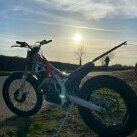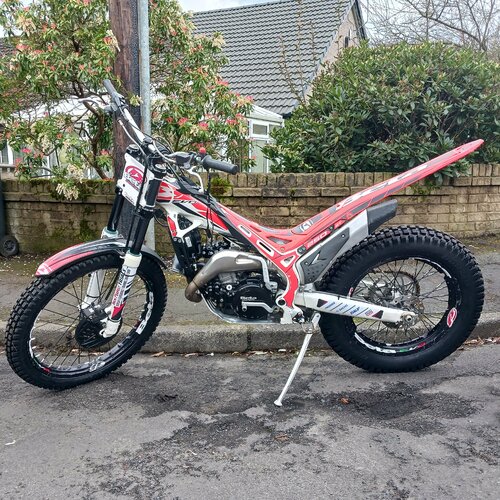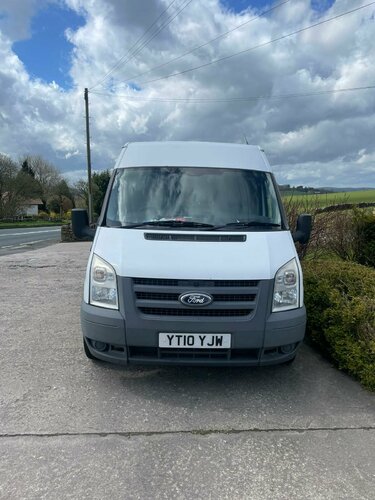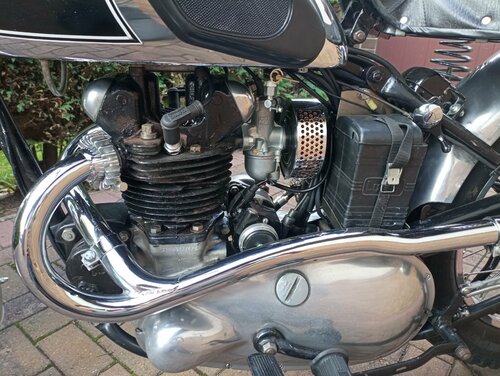All Activity
- Today
-

Beta 4T vs Montesa 4RT (and 250 vs 300...)
jonnyc21 replied to NoTraction's topic in General Trials Talk
I have an 07 250 4RT and a 17 300RR Montesa and spend some good time on a 18 Beta 300 4T. For the most part they are very close however the Montesa has more pull at the low end with the Beta being softer on the low end. The Montesa has just a bit smother throttle through the full range with the top end of both being so close I couldn't tell the difference. The Montesa when swapped for a quick throttle tube (they come stock with a slow/black one) is a lot more aggressive than the Beta even my 250 is more lively with a quick throttle than the Beta however not as much pull as the 300 Beta above the half way point to the top but rev's quicker for sure. The Montesa seemed to carry the weight a bit lower and feels more planted than the Beta did, I found the Beta to be more lively for the suspension and even though the Montesa where adjustable can be nearly the same it still feels a bit less so I think because of how it carries the weight. On the traction side of things I find the Montesa to be much better in the wet than any of the 2T bikes I have been on (Gas Gas 125/250 2T, Beta 250/300 2T) however different and if your used to a 2T it will take some time to adjust to the difference. Between the two I side to the Montesa for the EFI over all considering the only adjustment I have ever had to do is idle/tick-over at very high elevation. Hope that helps a bit with at least one persons experience between a Beta and Montesa 4T. PS, Maintenance on the Montesa is more complex with the way they do the oil filter so that might be worth note. -
The Nationals will be November 8-9, 2024, at the Victoria Motorcycle Club property, in Victoria, BC In addition, we are working with the NATC to combine the Canadian Nationals with the the Donner CA Nationals on July 27th/28th as the North American FIM Championship. Would be great if the CMA could get the 2025 event sorted earlier - I believe Derek has offered to host it as well always great to have choices. The "Canadian Trials Initiative" is a handy spot to keep up to date with things.
- Yesterday
-
This years CMA National is Still a best kept secret, although rumour has it an event is slated somewhere on the Vancouver Island in the late fall. Wish I had known this is how it is going to be earlier and I would have booked my July 20&21 as a national, too late now. I'm going to say it right now that I'm hosting a CMA National competition in 2025 and it will be some time after bug season but before school starts so people can actually plan to travel, attend and participate. You want to know what CMA really is to trials riders and to the people that actually make events happen, CMA is just another obstacle. They don't even broker insurance any more, they sell competition licenses. CMA Tips and tricks: Buy your competition license well in advance and save a few bucks. Pre-register for events in time and save a few bucks. If you hold a competition license for 25 consecutive years you qualify to become a life member and your competitor license will be half the price from that time forward and you can save a few bucks. Never send them any more money then you need to. Never ask CMA anything ever, just tell them how it is going to be. That's how to deal with CMA.
-
Thank you for our reply. Unfortunately your photograph show the correct type of timing cover. My cover is the whole length of the right hand crankcase, covering the drive sprocket. I think a photograph of mine would be an advantage to identify it Thank you, Peter Lee (Cornwall)
-

Beta 4T vs Montesa 4RT (and 250 vs 300...)
NoTraction replied to NoTraction's topic in General Trials Talk
Thanks guys - helpful stuff 👍 -
lemur started following CMA ATA - ARDEN Ontario Provincial TRIAL - MAY 5TH, 2024
-

Beta 4T vs Montesa 4RT (and 250 vs 300...)
markparrish replied to NoTraction's topic in General Trials Talk
I can't offer any help with comparison, but my 250 Beta 4T is great for me in the mud and slippery chalk down south! I'm far from being an expert rider but find the softer delivery much easier to manage in slippery stuff than my previous 2T. It seems to pull nicely in any gear - I don't do hops and jumps...just plodding round! -

Beta 4T vs Montesa 4RT (and 250 vs 300...)
lemur replied to NoTraction's topic in General Trials Talk
The fuel injection on the 4RT is superlative, it's the feature most lacking on the Beta 4T. Whoever told you the 4RT is not good in mud is simply wrong, the 4-stroke excels in the mud or on snow and ice. The Montesa suspension feels far more grounded than the TRS which has an extremely lively suspension. I owned several versions of the 4RT and found the 300cc engine to be superior for pulling 3rd. gear. Two things you need to adapt to when going to the 4T from a high performance 2T: one is you need to calm your throttle movements and avoid blipping the engine, and two you need to learn to carry more revs in advance of needing the power. This is the first year since 1976 that I don't own a Montesa and at times I do miss them. I don't think there is anything I can do on my TRS 300RR's that I can't do on a Montesa 300, although the TRS just seems more fun and exciting to ride overall. Things I miss about the Montesa is cheap and easy fuel consumption and the Montesa was a far better bike to stud the tires and ride in winter. Montesa won't start if the engine is sub-zero, if it gets that cold you need to build a fire under it to thin the oil. In sub-zero the TRS lithium battery electric start is useless so you need to kick start it to play. Beta 4T from my experience was a #$%^ to start all time, particularly after a fall. Montesa wants to keep running even if the bike is upside down which is why it has a tilt switch to shut it down in a crash. -
NoTraction started following Beta 4T vs Montesa 4RT (and 250 vs 300...)
-
Following on from my other Beta thread... can anyone comment on what the Beta 4t Evos are like? Are the 300's a mellow well handling bike? And how do they stack up against the 4RT? I've had a slight hankering for a 4RT and like the idea of a 4 stroke generally but whenever I mention I usually get told that it will be no good in the mud (we get LOTS of that where I am) and that 'Ill get fed up with the weight of it. Not so worried about the weight, it would be lighter than my Fantic, I'm sure! But after enjoying my TRS and previously my Gas Gas (which I loved) I'd be a bit concerned about buying something thats going to be a pig to ride then regretting it, just because it looks and sounds nice... stick to a two stroke, they all say....! But is it it the case and is the Beta 4t of either 250/300 variant any more forgiving/better/worse in wet muddy UK conditions..?
-
Thank you both for your input. Very helpful in sorting this out.
-
hopefully this is the culprit
-
I think that the cover you describe will fit the earlier 247 models. My 1982 248 looks like this on the drive side
-
It goes behind the piston.
-
The PHBH is a larger version of the PHBL. The PHBL is a small body carb used on trials bikes to save space, with a maximum bore size of 26mm whereas the PHBH goes from 26mm to 30mm and I think your cota would be a 26mm. I wouldn't think there would be any gain going from 26 PHBH to a 26 PHBL. The Keihin is a Flatslide 28mm and will give you more topend power if that is what you are chasing and they are pretty much standard on most newer bikes, but there is nothing wrong with a Dellorto.
- Last week
-
yea...
-
I have a 1981 Montesa 248 Cota. Engine No 21 M 51176. I need to replace the right hand timing case. I have looked at the parts manual and it indicate just a timing cover with a plastic chain guard above the front sprocket. The cover fitted to my engine is the whole length of the right hand crankcase and originally covered the front sprocket. It has a cut out at the front which perfectly matches the rubber grommet where the ignition leads exits. Does anyone Knows what Montesa model this timing cover comes from ?. The retaining screws all line up perfectly and the casing has the Montesa motif on it. Before I remove the damaged part are there any internal numbers that may assist. Regards, Peter Lee (Cornwall)
-
It's a brushed electric motor, if you put more volts through it then the windings are rated for of course it will spin a little faster, right up until it fries. Stepping up the voltage with an additional battery array and then adding a step-down transformer to bring the voltage back down to suit the motor was an expensive and complex way to increase the battery capacity feeding the original motor.
-
That's not true. Power is proportional to torque times RPM. Increase the voltage available to a DC motor and you can increase its maximum RPM capability. Whether or not that will improve an Oset, I have no idea. Whether or not the reliability of the Oset system degrades to an unacceptable level, I have no idea. I've outlined some basics here (and in subsections): https://www.electricmotiontech.com/home/ev-tech-101
-
You're not going to get more power out of the same motor, you need to change the motor to one that operates on higher voltage and is capable of drawing the additional watts. Watts is the measure of power and heat, volts is the measure of electron push. Then you need a motor controller that is suited to that motor. Basically the motor horsepower upgrade path on an Oset is to add batteries and replace the 2 most expensive parts, the motor speed controller and the motor. Pavement is about the only place they will be able to use the extra power, everywhere dirt will be wheel spin because the small diameter rear tires are marginal on loose or slippery surfaces.
-
Hopefully new version is stronger😜
-
What does the tag on your motor say? Attached is the tag from a little Oset motor and what it says for power is all it can handle. I'm guessing the motor you have indicates a voltage range and not a fixed voltage? ... & are we seriously talking about souping up a kids electric scooter 🤔 that usually means it is time for a full size motorcycle.
-
I have zero experience with Osets, but can you open the controller and have a look inside? The DC link capacitors (large electrolytics) will have a voltage rating written on them. The power MOSFETs will have a part number that you can search to find a datasheet that will specify its maximum voltage. In both cases, you want to have a safety margin between their ratings and your maximum operating voltage. The closer you cut the safety margin, the worse the long-term reliability. You can buy electronic speed controls (ESCs) for electric bicycles very inexpensively.
-
Hi, thanks for the repsonse. It was your video on the Reiger that made me aware of the tooling. I wish I had seen and watched it first. I had to make an oil bleed setup which was not a problem but hit the wall with the nitro setup. The Reiger on my One R has rebound adjust only but it does have the clevis. I have an R16V off of a 2018 Montesa 4rt which is spherical end piece. I read that the Reiger B40 can work on my bike with a change in linkage so I am willing to do that if there is another shock that will work. Is the R16v worth messing with? I don;t have a problem with the base Ohlins as I dealt with them for years and there is a guy here in the states that has a pretty hot setup on those. But I will email you about the tooling. I hate having people work on my stuff if its something I can do so if its possible to obtain any of those tools that would be awesome.
-
Recent Topics
-
Classifieds
-
TC News Feed







